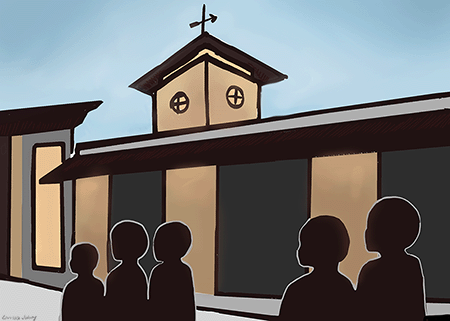Students and Teachers Reflect on the New Schedule
How does the Academy community feel about the change?
After Albuquerque Academy unveiled a new schoolwide schedule this year, The Advocate wanted to get the inside scoop on how teachers and students have adjusted to the change and how they feel about the new format almost a year in.
The reaction to this schedule has been generally positive, with many teachers saying that they now have more time to prepare lesson plans for their upcoming classes, as well as being able to grade assignments and tests quicker. Some also appreciate the elimination of “exam days” that were previously assigned to each department to determine when each class would have to take a test. Math teacher Jason Zuffranieri said, “I love the fact that I can give a test any day.” While tests may be more prevalent nowadays, English teacher Ben Dolan says there has still been “a tangible reduction in student overwhelm” thanks to the new schedule, saying that it forces faculty to be purposeful when assigning homework since they cannot give it every day. Dolan also believes that he is able to “finish things more fully” and discuss texts in more depth because of the longer class periods, saying that previously, “I felt constantly interrupted.” Most teachers do believe that they are still able to get through the required content in their classes despite only meeting every other day by what Zuffranieri referred to as “restructuring” how they teach. For example, science teacher Nick Rubie began using a flipped classroom model this year, where students listened to recorded lectures at home and practiced new material during class time, to ensure that his AP classes learned everything they needed to before the exam.
Rubie, however, also said that there was not enough class time to engage students in laboratory experiments and noted that, even after switching to a flipped classroom model, he “cut out almost all the labs” this year to be able to teach all the content. World Languages instructor Marcela Espinoza feels similarly and highlighted the difficulty of getting through material, especially in AP classes, and preparing students for the next year, saying, “This schedule is not convenient for language.” She also stressed that seeing her students every day would help solve this problem, giving everyone “practice [and] consistency” and help her connect more to them, something she feels she hasn’t been able to do because of the new schedule. She also wonders if this schedule is truly suited toward younger students, saying that many in middle school cannot focus for 75 minutes at a time and suggested that their classes should only be 45 to 55 minutes long.
Another noteworthy drawback of this new schedule are the distinctions between the two lunch periods. Many students felt that they needed to get lunch earlier than their assigned time, leading to the administration warning of automatic detentions if any 10-12 student entered the dining hall before 11:30. Josh Baker ‘24 said, “Everyone goes in [to lunch] during office hours or club time,” and questioned the necessity of having two different time slots for lunch. He proposed having each grade eat at a different time, but otherwise praised the schedule, saying that it works for students like him.
However, it isn’t necessarily beneficial to all students. While Becca Faber ‘24 noted that she enjoys having the opportunity to get more done in class, she also believes that teachers are assigning more homework as they’re able to cover more ground at school. She also dislikes that she only gets to go to half of her classes every day.
Teachers also widely claimed that there was only a minimal opportunity for them to comment and suggest changes to the schedule when it was being developed, and Rubie mentioned the repeated switching of schedule configurations from the version with the 9-day cycle to the one with trimesters during the pandemic, and now this new version, saying, “It’s been a lot to cope with.” Dolan also noted this, saying, “While this is a good change, it came on the heels of so much other change.”
While the schedule seems to be working well for the majority of teachers, those who teach at higher levels are struggling to get through the content they need to without having to make changes to the way they would normally teach. For students, it seems they have adapted to longer class periods but wish lunch was earlier so they could focus more during class. No schedule will ever be perfect, but it seems most are satisfied with this latest iteration.

Uzair Hammad '24 has been a writer and editor for The Advocate for four years, finally ascending to the fabled position of editor-in-chief. In his free...

Haley ‘25 is the Advocate’s Graphic Art Editor. Their overall artist career sprouted at a young age from their various dragon sketches and drawings,...







Roberto • May 6, 2022 at 2:04 pm
Well written! I would only add that one of the strengths the Academy always had was the unique and special bond formed through the daily contact of students and faculty. A classroom of trust where both parties share in the subject matter while also sharing about themselves.
AA is a school like no other, with students/faculty like no other. Without the consistent challenge, discussion, and reflection on a daily basis, the students will work to finish rather than work to discover and learn. Because with trust comes honor, honor for the student to work hard for the teacher and the teacher to work hard for the student. Without that daily contact and trust, how can expectations of extending the general concepts and skills be achieved by either student or teacher? The school will be like all others, do homework, pass the test, and move on to the next class.
Next time you see your student/teacher, ask yourself how well do I know that person? Can I see in them having a good or bad day? Can I see if they need help with homework or life? Can I be there to support in either case?
$0.02